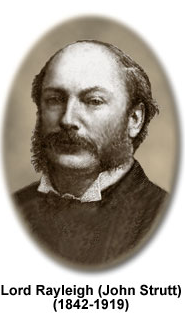Light Scattering: Why is the Sky Blue
Claimed by Zhaoxian Zhang (Summer 2022)
Light scattering is the change in momentum and energy of light when it passes through an object. Light scattering occurs because light, as a form of electromagnetic wave[link], interacts with charge. This often happens with light interacting with dipoles[link]. dusts in the air, molecules in the air, particles in solutions, water droplets, and many other common things can form dipoles. These interactions lead to everyday phenomena like whiteness of cloud or the redness of sunset, and even governs the color of the sky.
Light scattering can be characterized into elastic or inelastic scattering, depending on how energy is exchanged during the interaction. In elastic scattering, the scattered particle conserves its original kinetic energy.
Mathematical Models of Scattering
In modeling scattering effects, a dimensionless parameter [math]\displaystyle{ x }[/math] is often used to characterize the size of the scattering particle in relation to the scattered wavelength. It is calculated with the following relation: [math]\displaystyle{ x = \frac{2 \pi r}{\lambda} }[/math] When [math]\displaystyle{ x\lt \lt 1 }[/math], or when the scattering particle is much smaller than the wavelength of scattered light, the scattering event can be characterized by Rayleigh Scattering[link]. When the particle size is larger, the scattering event is characterized by Mie theory[link] or discrete dipole approximation[link] by solving Maxwell equations[link].
Computational Models of Scattering
Examples of Scattering
Compton Scattering Compton scattering is an example of an inelastic scattering event, in which a photon gives a part of its momentum to an electron when it collides with it and scatters off at an angle. Because the transfer in momentum, the photon changes its wavelength after collision. The amount of change in wavelength can be derived from conservation of energy and momentum. Recall the energy equation: [math]\displaystyle{ E^2 = (\rho c)^2 + (mc)^2 }[/math] Since the energy lost by the photon is gained by the electron, [math]\displaystyle{ \delta E_{photon} = -\delta E_{\electron} }[/math] Consider the change in momentum of the photon, as it flies off at a different angle, is simply the vector difference of the momentums. When squared in energy calculation, this difference can be simplified using scalar product: [math]\displaystyle{ \delta E_{\gamma} = (vec{P_{gamma}}- vec{P_{gamma’}})*(vec{P_{gamma}}- vec{P_{gamma’}})c^2 \delta E_{\gamma} = (P_{gamma}^2 + P_{gamma’}^2 - 2 P_{gamma} P_{gamma’} cos \theta )c^2 }[/math] For momentum of a photon [math]\displaystyle{ P = hf/c }[/math], the above expression becomes: [math]\displaystyle{ \delta E_{\gamma} = ((\frac{hf}{c})^2 + (\frac{hf’}{c})^2 - \frac{hf}{c} \frac{hf’}{c} cos \theta )c^2 }[/math] Alternatively, the square of the change in energy of the electron is: [math]\displaystyle{ \delta E_{\e} = (mc^2)^2 +(\delta P_{gamma} c)^2 \delta E_{\e} = (mc^2)^2 =(\frac{hf}{c} - \frac{hf’}{c})^2 c^2 }[/math] Equate these expressions in energy and simplifying, we eventually get to the equation describing Compton scattering: [math]\displaystyle{ (\lambda - \lambda’) = \frac{h}{m_{e}c} (1-cos \theta) }[/math] Which describes how the frequency of the photon changes when scattering from an electron.
The Blue Sky While the derivation of original Rayleigh scattering equations is much more complicated, a simple dimensional analysis, as Lord Rayleigh did in his first analysis, is much simpler and reveals how the sky appears blue. Say the scattered light has electric field [math]\displaystyle{ E_{s} }[/math] . The intensity of the scattered light ==Connectedness
History
John William Strutt (Lord Rayleigh) (1842-1919) was born in the United Kingdom. He made fundamental discoveries in the fields of acoustics and optics that are basic to the theory of wave propagation in fluids. He was also responsible for much of the early discoveries in scattering.
His work on scattering began with the question of the color of the sky. John Tyndall[link] first discovered that light scattered from small particles appeared blue from the famous Tyndall effect. But it was Lord Rayleigh who worked out the math and solved the mystery of the color of the sky.
See also
Further reading
Read more about:
- Lord Rayleigh (John Strutt): http://micro.magnet.fsu.edu/optics/timeline/people/rayleigh.html
- Isaac Newton: http://www.biography.com/people/isaac-newton-9422656
- Electromagnetic and Visible Spectra: http://www.physicsclassroom.com/class/light/Lesson-2/The-Electromagnetic-and-Visible-Spectra
- Dispersion of Light by Prisms: http://www.physicsclassroom.com/class/refrn/Lesson-4/Dispersion-of-Light-by-Prisms
External links
http://science.hq.nasa.gov/kids/imagers/ems/visible.html
http://www.sciencekids.co.nz/sciencefacts/light.html
References
http://www.sciencemadesimple.com/space_black_sunset_red.html
http://missionscience.nasa.gov/ems/09_visiblelight.html
http://www.livescience.com/50678-visible-light.html
http://www.livescience.com/32559-why-do-we-see-in-color.html
http://www.webexhibits.org/colorart/bh.html
http://www.edmundoptics.com/technical-resources-center/optics/introduction-to-optical-prisms/
http://www.britannica.com/biography/John-William-Strutt-3rd-Baron-Rayleigh

